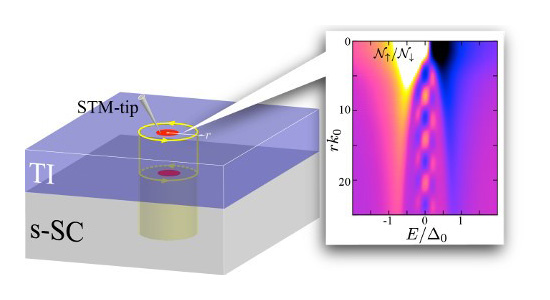- Home
- > Research
- > Research Highlights
- > Vol. 25 Majorana Particles in Topologi・・・
 Research Highlights
Research Highlights
[Vol. 25]
Majorana Particles in Topological Superconductors: Search for illusive particles equivalent to their own anti-particles
Theoreticians at MANA report on the existence of Majorana-type particles based on analysis of independent scanning tunneling spectroscopy measurements on thin film of topological insulator bismuth telluride on substrate of superconducting niobium selenide. The findings are important for robust topological quantum computing.

Figure: Schematic of Majorana particles localized inside the core of quantum vortex of a topological superconductor and the distribution of density of states of quasiparticle excitations based on the theoretical calculations.
In 1937 the Italian theoretical physicist Ettore Majorana predicted the existence of fundamental particles with mass, no charge, and intriguingly, “equivalent to their own anti-particle”. The search for these “Majorana fermions” (also known as Majorana particles) has been lasting for almost 80 years without a firm answer. An electron is not a Majorana particle because it is negatively charged, and its anti-particle is positive (positron), thereby a different particle, a fact that does not follow Majorana’s prediction.
Now, Takuto Kawakami and Xiao Hu, theoreticians at the International Center for Materials Nanoarchitectonics (WPI-MANA), National Institute for Materials Science (NIMS) report on the existence of Majorana-type particles based on analysis of independent scanning tunneling spectroscopy measurements on thin film of topological insulator bismuth telluride on substrate of superconducting niobium selenide, which composes a topological superconductor [Xu et al., Phys. Rev. Lett. 114 (2015) 017001].
Kawakami and Hu carried out precise analyses on quasiparticle excitations and found that Majorana particles were captured inside quantum vortex cores of the topological superconductor. Notably, the NIMS researchers propose that the quantum mechanical properties of Majorana particles could further be exploited to develop a method to improve the precision of experiments. They state that their research is “expected to be able to provide phase-sensitive evidence for a Majorana particle in the vortex core of a topological superconductor.”
These results together with advances in materials science are significant steps towards the realization of robust quantum computers that would be less prone to ‘decoherence’—so-called topological quantum computers.
Reference
"Evolution of Density of States and a Spin-Resolved Checkerboard-Type Pattern Associated with the Majorana Bound State"
Takuto Kawakami and Xiao Hu
Journal : Phys. Rev. Lett. 115 (2015) 177001.
DOI : 10.1103/PhysRevLett.115.177001
Takuto Kawakami and Xiao Hu
Journal : Phys. Rev. Lett. 115 (2015) 177001.
DOI : 10.1103/PhysRevLett.115.177001
Affiliations
International Center for Materials Nanoarchitectonics (WPI-MANA), National Institute for Materials Science (NIMS), Namiki 1-1, Tsukuba, Ibaraki 305-0044, Japan
Contact information
International Center for Materials Nanoarchitectonics(WPI-MANA)
National Institute for Materials Science
1-1 Namiki, Tsukuba, Ibaraki 305-0044 Japan
Phone: +81-29-860-4710
E-mail: mana-pr[AT]ml.nims.go.jp
1-1 Namiki, Tsukuba, Ibaraki 305-0044 Japan
Phone: +81-29-860-4710
E-mail: mana-pr[AT]ml.nims.go.jp

